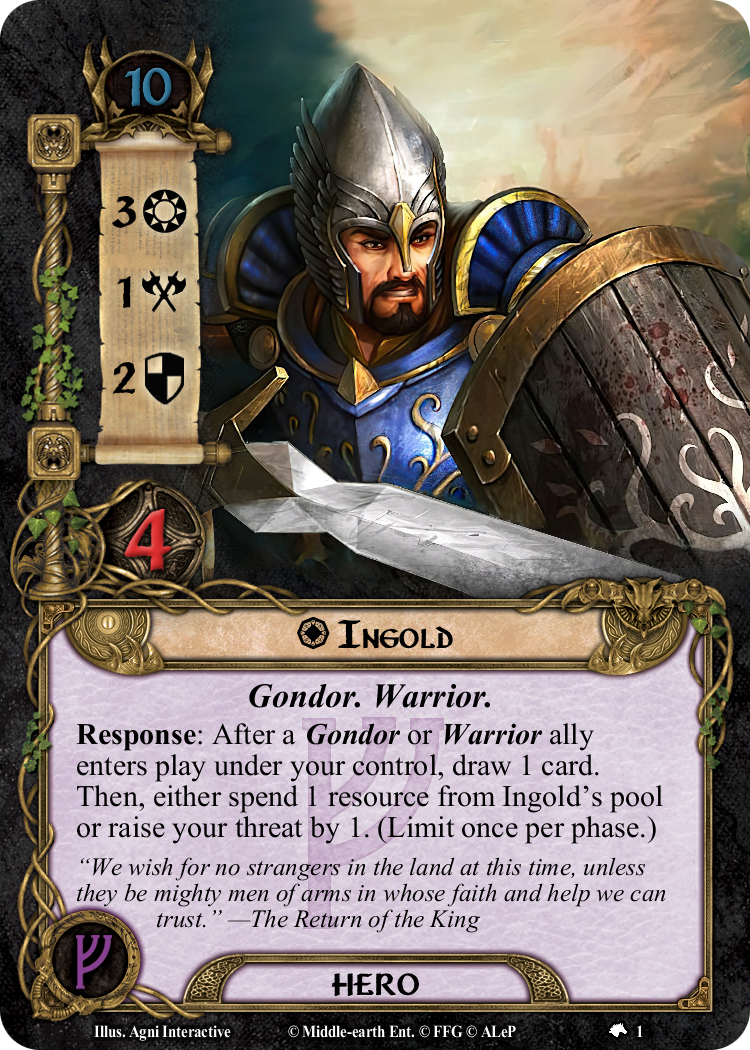What an interesting hero! To start us off, I'll go over some of the more obvious things. The artwork is very good, so nothing to complain about there. 3 is fantastic (and can even be boosted with Visionary Leadership), and provides your deck with strong turn one . The is really low, but can come in useful if you manage to ready Ingold. The 2 in combination with 4 means Ingold can take smaller attacks easily, and even a large one without perishing in a pinch. For 10 this is really good value, exactly what you'd expect, 10 stats for 10 .
Now to get on to the interesting part, the ability. Ingold's ability obviously works well in Gondor decks or even in decks that support many Warrior allies such as Rohan. The ability is great because it patches one of the major flaws of Gondor decks: card draw. Previously the only thematic options were Pillars of the Kings and Rod of the Steward. Card draw was especially hard to come by as Gondor decks tend to be and , which can both struggle with card draw. But with Ingold's ability, you can draw an extra card every round assuming you play a Gondor ally.
Now of course, this response isn't free, it comes with a few costs. Every time you activate the response, you have to either raise your threat by one or spend 1 resource from Ingold's pool. Raising your threat in Gondor decks is barely even a cost because you usually want to hit 40 as soon as possible anyways to activate your Valour triggers. Once you hit 40 , spend the resource to pay for Ingold's response because by that point you will have enough resources lying around to pay for the effect anyways, and you will be glad to spend one resource for an extra card.
The second restriction is the response's restriction of "Limit once per phase". At first glace, this means you can only get one extra card per round because you can only play allies during the planning phase. But that is not strictly true because there are several ways to play allies out of the planning phase. Hirgon is a thematic example that lets you play a ally during the quest phase, netting you an extra card in exchange for 1 raise or 1 resource. Sneak Attack and Reinforcements are a no brainer (in sphere) examples, and so is A Very Good Tale. Open the Gates is an option included in this expansion, as is Morwen Steelsheen. There are many other options such as Elfhelm and Stand and Fight. Lothíriel is another particularly interesting example because she's thematic, as is her father. With all these options, its very easy to consistently get more than one extra card per round with Ingold. The cost will raise your threat very quickly, but thats good because you will get to Valour much quicker, will allow you to quickly find important cards such as Angbor the Fearless, Visionary Leadership, and Errand-rider. Alternatively, using Ingold's response can be great for activating A Perilous Voyage more quickly.
Well, that's it from me. I hope you found my review useful, and I encourage you to experiment with the hero like I have. He's seems very well balanced to me, and really changes the way you think about your turns because deciding if you need another card and how to pay for it adds a really interesting dynamic to every turn, especially in the early game.
“I love fools’ experiments. I am always making them.” - Charles Darwin.
